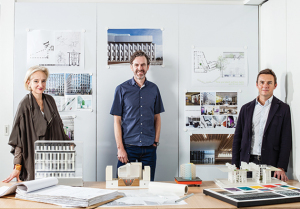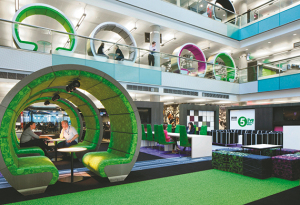 In a world where property design trends are bigger, bolder and moving faster than ever before, what does it take for an architectural practice to maintain its edge? In the case of Sheppard Robson, sometimes it is down to pure grit.
In a world where property design trends are bigger, bolder and moving faster than ever before, what does it take for an architectural practice to maintain its edge? In the case of Sheppard Robson, sometimes it is down to pure grit.
“It is so often about holding your nerve,” says Helen Berresford, head of ID:SR, the practice’s interior design group, and the brains behind designs at the new Channel Four building, Exemplar’s Fitzroy Place and BBC North. “That is usually the key to being ahead of what everyone else is thinking. Holding your nerve and running with it.”
And that is something the 370-strong team at the 75-year-old practice has down to a tee. From its bold redesign of the London Business School to its futuristic Interserve Hub in Birmingham, the team – spread across three offices in London, Manchester and Glasgow – has made its mark with show-stopping designs across a plethora of sectors.
But what happens when the definition of a great design moves away from being just a striking façade? As the value of iconic towers with tiny floorplates is increasingly called into question, schemes need to be more than just beautiful. They need to be smart, efficient, green, flexible, agile and user friendly.
Berresford and fellow partners Lee Bennett and Alan Shingler reveal how they are designing from the inside out to cater for an increasingly demanding client base of occupiers and developers.
Flexible interiors
Like the start-up revolution itself, much of the change that Sheppard Robson has seen over the past few years was kick-started by the recession.
“Like a lot of people, we ironically ended up finding the recession to be quite a creative period,” says Berresford. “My mantra ‘more choice, less space’ became incredibly prevalent as we started to think, as designers, about how to best make use of resources. It took more intellectual thought and more depth to be able to help businesses at that time.”

That approach is something the team has carried over into the good times. Digital and tech advances have accelerated the need for more efficient, flexible interiors across all sectors. “Around 86% of an organisation’s cost will be people. And the way people are working now is changing so quickly,” says Berresford.
“We are always trying to catch up with these trends as designers and this is where flexibility comes in. When we started BBC North the iPad hadn’t even been invented.
“But it still works now because the agility was built in with a focus on amenities rather than desks and introducing work spaces tailored to a range of activities.
“Allowing choice when it comes to where and how people work is the future. I think offices are becoming much more of a destination to attract and retain. And it is not just about offices, but whole places. Placemaking is so important as the lines between live, work and play blur,” she adds.
Public realm
And this is where the practice’s design ethos leaps from the inner workings of building design to the other end of the spectrum – the impact of a scheme on the wider area.
“If you cast your mind back to 2006, pre-recession, there was a huge emphasis on how a single building looked,” says Shingler, who heads Sheppard Robson’s residential projects. “Now there is far less emphasis on the image of the building and more on what it can offer. And that has to start from the masterplan stage. It is about how it sits, the place. Where it is and what is around it.”
“It is about the whole setting,” adds head of education Bennett. He refers to Legal & General’s 245 Hammersmith Road, W6, as a case in point. The £90m project will not just see the redevelopment of the building formerly known as Bechtel House but will create nearly 70,000 sq ft of public spaces as part of the local business improvement district. “This public realm has been created from nothing,” he says.
“We managed to incorporate elements in the design to create a new public plaza at ground level, we reactivated a redundant 1960s plaza at second-floor level and we turned the reception area into a big, open communal space to complement the new public area.”
Shingler adds that it is this focus on the bigger picture and delivering something extra that helps the firm stay one step ahead when it comes to keeping developers and occupiers onside.
“We aim to deliver something that enhances the value within the remainder if the project. Something that was not necessarily part of the original brief,” he says.
And this, he adds, is where the relationship between the developer and the architect comes in – a relationship that is arguably more important now than it has ever been before.
“Many people, including ourselves, would say that the most important person in the whole design team is the client,” says Shingler. “But any client still needs a good designer to create the vision.”
He adds that buy-in from the occupier or developer is still crucial for a successful scheme both in terms of creativity and value. Something that is much more effective if it is secured at that masterplan stage.
“If you can get that buy-in early, then that is where you can work in some uniqueness, whether it is a park or a roof garden or a cool breakout space,” says Shingler. “Defining the vision with the client at the very beginning is key, which is why I like to work with developers that have real ambition. It is so much better if they are part of the process.”
Looking outside London
As for what is next for the practice, the trio – who are just three of 22 partners across the group – are quick to say that it is not all about headline schemes in the UK capital.
After growing from 250 staff to 370 in the past 18 months, the company is actively looking to expand in Manchester and Glasgow where it has a swathe of work in the pipeline including the 150,000 sq ft New Victoria scheme in the former and two major new-build commercial developments in the latter.
“We have just taken bigger offices in Glasgow,” says Shingler. “We are seeing some real growth opportunities in Scotland. Most of our work here has been universities in the past but now we are seeing the commercial market come back. And that is what has made the difference there.”
And Berresford adds: “Manchester and Birmingham are actually becoming much more attractive to some of our London clients, which might have traditionally stayed in the capital. ”
The practice is keen to keep to just the three offices to maintain a sense of cohesion – not least because the outposts work very closely together. Every design goes through an internal review before it makes it out of the door.
“All projects are reviewed by us and it pulls the offices together,” says Bennett. “Everyone knows what everyone else is doing and it helps us to encourage innovation and foster creativity.”
That and perhaps instilling a bit of that true grit. After all, sometimes only holding your nerve will do.











